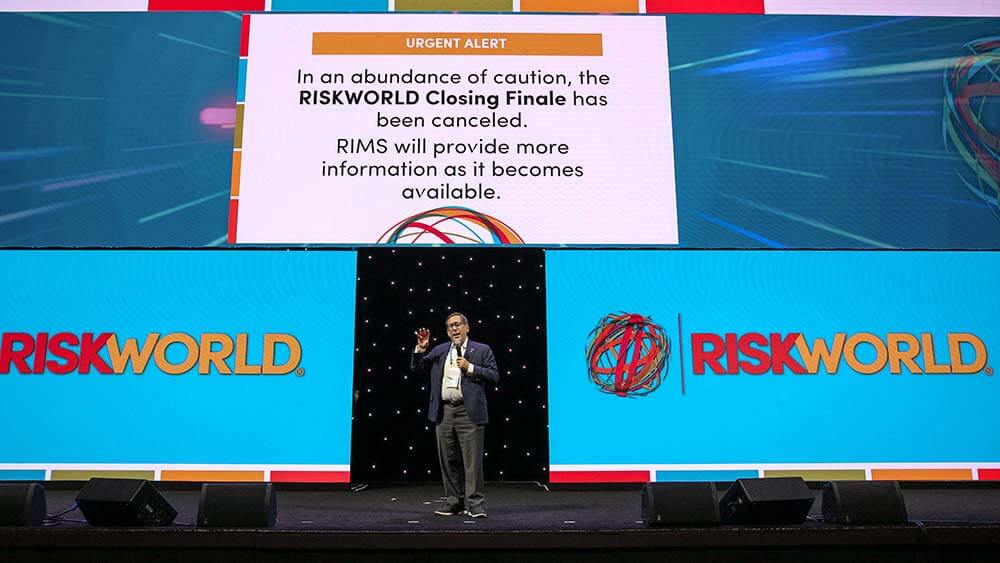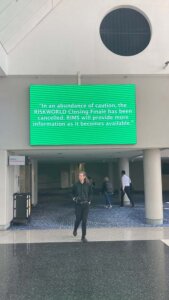
RIMS President and CEO Gary LaBranche films a video for RISKWORLD attendees after part of the event was canceled in early May due to an active shooter in Atlanta.
The fear that an active-shooter situation could happen at his event has been at the back of Gary LaBranche’s mind for a while. This year, when a mass shooting on Feb.12 on the campus of Michigan State University resulted in the deaths of three students, LaBranche — CEO of RIMS, the risk management society® — along with other RIMS staff were in Atlanta on a site visit preparing for their annual meeting, RISKWORLD 2023.
“It sort of dawned on me that conventions are vulnerable, soft targets,” LaBranche told Convene in an interview last week. “When you bring thousands of people together in or near an urban center, in our current environment, one has to assume that you could very well become a target.”
It wasn’t until Wednesday, May 3, the fourth and final day of RISKWORLD, when that fear would unfortunately become a reality. Around 11 a.m., a suspect entered Northside Medical Midtown in Atlanta’s Midtown neighborhood and began shooting, killing one person and injuring four others. The suspect fled on foot, hijacking a car and setting off a manhunt that would last more than eight hours, according to CNN.
Moving Fast
Meanwhile, about two miles south at the Georgia World Congress Center (GWCC), RIMS staff were prepping for the arrival of their closing keynote speaker, racecar driver Danica Patrick. This year, RISKWORLD had drawn more than 9,000 risk professionals from 60 countries to Atlanta for 150 educational sessions, a marketplace with 400-plus exhibitors, as well as an array of social networking events. When the call came from GWCC authorities that an active shooter was in the area and unaccounted for, RIMS staff immediately shifted into emergency-response mode.
As the association that puts on the “Super Bowl or World Cup of business insurance and risk management,” as Stuart Ruff-Lyon, CMP, DES, chief events officer for RIMS, describes it, crisis planning is naturally part of RIMS’ protocol. RIMS’ crisis management and communication plan for RISKWORLD, much of it informed by industry experts who sit on RIMS’ board, spans 60-plus pages. And leading up to this year’s RISKWORLD in Atlanta, the RIMS team took extra steps to prepare by collaborating with the GWCC’s on-site police department, as well as other local authorities, to ensure they were covering all the bases should a crisis arise.
Shortly after RIMS learned of the shooting, the team, along with the GWCC police department, quickly convened on how to proceed. At that point, the whereabouts of the suspect were unknown. Local police had set a wide — and constantly shifting — security perimeter around the location of the shooting, about 2.5 miles north of the GWCC, instructing everyone within that perimeter to shelter in place. Adding to the urgency was a steady stream of unverified reports, including one that the shooter had boarded a MARTA (Atlanta’s rapid transit system) train and another that additional shots had been fired, both of which turned out to be false.
Relying on RIMS’ own crisis plans and the GWCC’s on-site police, staff quickly determined that the convention center was safe and secure. The next step was ensuring everyone associated with the event was aware and up to date on the situation, while also figuring out if and when they could proceed with the day’s agenda. In addition to e-mailing updates to attendees, RIMS staff used their mobile event app to send out push notifications. They realized they could also take advantage of the GWCC’s digital signage, controlled by one central system, to keep eventgoers throughout the campus continually updated. RIMS also found another on-the-fly opportunity to communicate updates — since they had already set up AV and film equipment for the closing session, they quickly filmed a video message from LaBranche, working with partners Freeman and CNTV, and posted it to their app and the RIMS website.
RIMS deliberated on when to make a call on moving forward with the rest of the day’s events. After a couple of hours, when it became clear that the shooter was still on the move, staff decided to cancel everything, including the closing keynote, several smaller events, and a sponsored closing party later that evening. In the end, they said, even if the shooter was apprehended ahead of the closing party, it wouldn’t have felt right to go forward.

The Georgia World Congress Center’s digital signage was “incredibly effective” at communicating real-time updates on the active-shooter situation to RISKWORLD attendees, RIMS staff members said, and the use of convention center signage will become a permanent part of their crisis plan for their annual meeting.
 Identifying Blind Spots
Identifying Blind Spots
Although LaBranche and his team, who spoke to Convene last week, felt they had gone above and beyond to prepare for a crisis like an active shooter situation, actually going through it in real life gave them valuable insight on where they need to focus more attention. “We do an incredible amount of staff training and pre-planning for these scenarios,” said Ruff-Lyon. For instance, this year for the first time, RIMS asked vendors to participate in a security webinar with trained staff on how to deescalate tough situations. They also keep the RISKWORLD website and event app updated with safety and emergency plans.
After the events of May 3, RIMS discovered that, for an active shooter situation, they need a wider frame of focus that includes their hotels, shuttle routes, and any other off-site locations in addition to their convention facility. “It was all [convention] center-focused,” said LaBranche of their previous planning, rather than a city-centered approach.
The footprint of RISKWORLD 2023 stretched far beyond the 220-acre GWCC campus, with a hotel block that comprised 32 properties as well as eight shuttle routes that stretched north to midtown, just blocks from where the shooting took place. Four of those hotels and two of those bus routes fell within the shelter-in-place zone. Using on-site technology that pings cell phones, RIMS was able to determine that roughly 7,000 attendees were on site immediately after the shooting. But that left about 2,000 who were likely in their hotels, en route to the GWCC or the airport, or elsewhere in Atlanta.
“One of the major learnings from this, is [the need to] expand our crisis communication plan,” said Josh Salter, RIMS-CRMP, ARM, director of communications for RIMS. “Right now, our crisis plan is very focused on events taking place at a convention center … it doesn’t really take a look at a major citywide event and how that can impact communications.”
For example, RIMS uses a text system to alert staff during an emergency, but nothing comparable for notifying attendees, exhibitors, and others involved with the event. Although the mobile event app offered “a lifeline” in that they could communicate via push notifications, it’s not a failproof solution, as the app was only downloaded by roughly half of their 9,000 attendees. The app also offers the option to shut off notifications. “Participants are at RISKWORLD to meet with other people and do business,” LaBranche said. “Many of them go to back-to-back-to-back meetings, from breakfast to dinner — they don’t want to be bothered. They don’t even look at their emails.”
RELATED: When Riskies Meet Swiftees
That means finding a new solution for communicating with eventgoers during an emergency that works, regardless of location. “We collect mobile phone numbers, but the next step is finding out more about this technology and what we can do to mass text 9,000 or 10,000 people at one time,” Ruff-Lyon said. He advises that planners of citywide conventions should consider doing the same, as well as ensure they have emergency contacts for their housing bureau, hotels, and transportation companies at the ready and ask those partners, in advance, about the crisis plans they have in place.
“This can happen in any city, at any convention, for any size association or company, and at any time,” LaBranche said. “And I think that’s the new reality. It is as unpredictable as a tornado, but it is as likely as a rainstorm — that’s the way we have to think of it. It’s not a matter of if, it’s a matter of when.”
According to recent data on mass killings — defined as four or more fatalities — from The Associated Press and USA Today in partnership with Northeastern University, the U.S. is currently averaging one every six-and-half days. Many happen at school campuses and workplaces, but they also take place at events and large gatherings — the deadliest mass shooting happened at an outdoor country music festival in 2017 in Las Vegas, where 60 people died after a gunman opened fire on a crowd from a window in a neighboring hotel.
“We need to have really serious conversations with our partners, with convention centers, with [DMOs], with staff, and everyone else involved in this great collaboration, because this is a part of our reality,” LaBranche said. “We’re all risk managers now, and we’ve got to figure out what that means and how to prepare for it.”
Handling Negative Feedback
Most of the feedback from attendees on how RIMS handled the active-shooter situation was positive. “Receiving praise from risk management leaders was extremely validating and RIMS looks forward to the opportunity to de-brief to improve our crisis response,” said LaBranche. That said, some negative criticism was voiced around RIMS’ speed of communications, with one exhibitor posting on LinkedIn that he wasn’t made aware of the shelter-in-place order affecting RIMS’ hotels until after it had been lifted.
RIMS staff said they are currently reviewing the timeline of their communications, and that updates were sent as soon as they could verify the information with the proper authorities. “We were learning things on the fly,” Ruff-Lyon said. “We were also walking that fine line of not wanting to create panic, either.”
“We were fortunate that our members, our attendees were safe and secure,” Salter said. “We got to put our crisis plan into action and test it in real life and in real time. It was definitely a learning experience … and something that [our team] is going to look at closely and figure out what our challenges were, and how we can make it better.”
Jennifer N. Dienst is senior editor at Convene.
